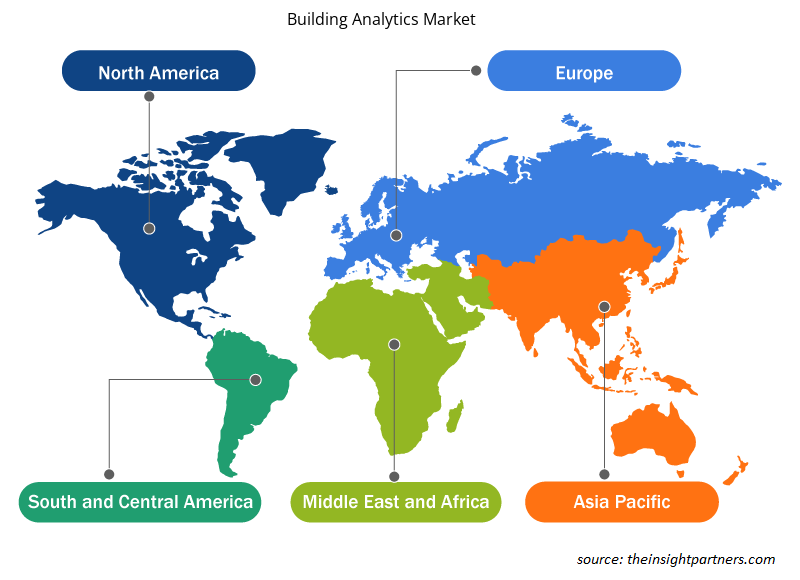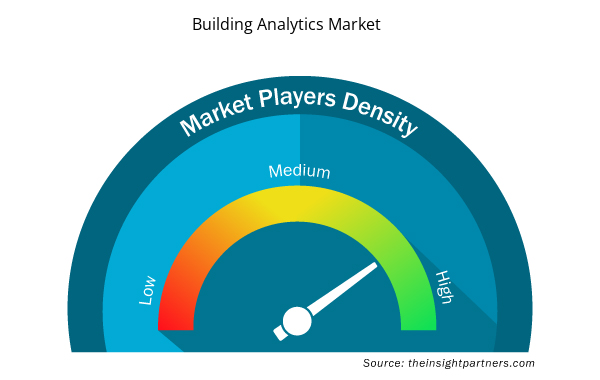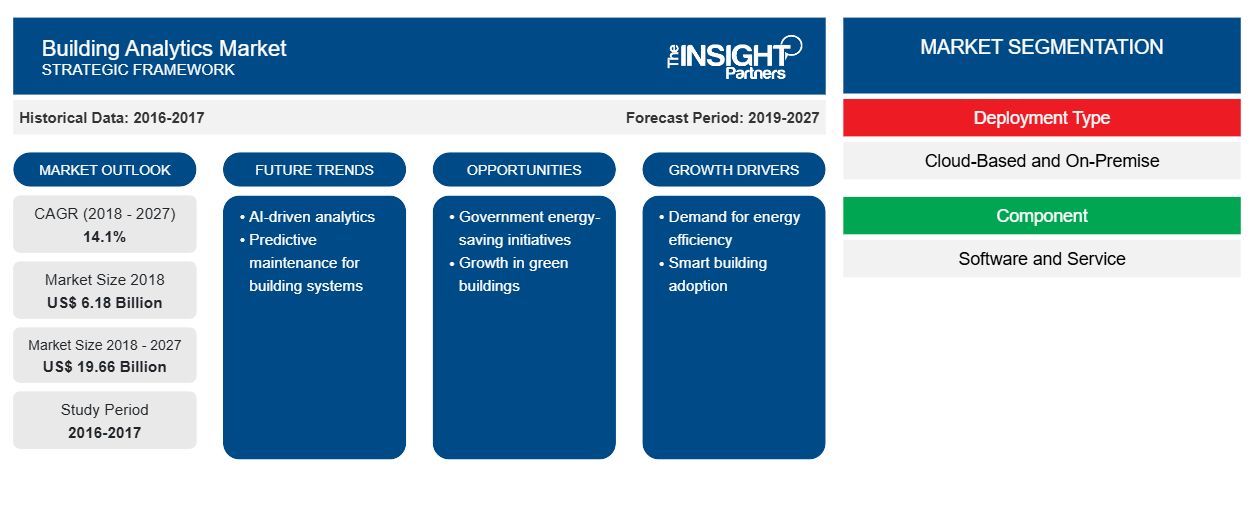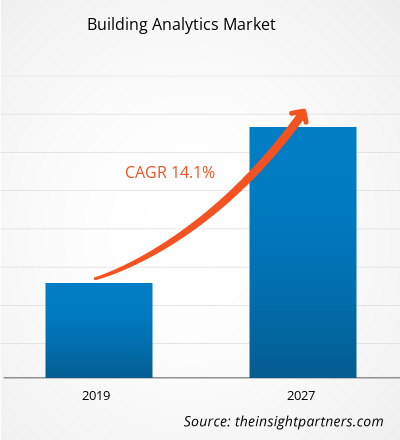Der globale Markt für Gebäudeanalysen wurde im Jahr 2018 auf 6.181,4 Millionen US-Dollar geschätzt und dürfte zwischen 2019 und 2027 mit einer durchschnittlichen jährlichen Wachstumsrate von 14,1 % wachsen.
Der Markt für Gebäudeanalytik wächst weltweit. Steigende Energiepreise, zunehmend strengere Richtlinien zur Gebäudeenergieeffizienz und das Erreichen maximaler Betriebseffizienz für das Gebäude- und Anlagenmanagement werden in den kommenden Jahren voraussichtlich die wichtigsten treibenden Kräfte des Marktes sein.
Der Bericht konzentriert sich auf eine detaillierte Segmentierung des Marktes für Gebäudeanalysen basierend auf Bereitstellungstyp, Komponente, Gebäudetyp und Anwendung. Die geografische Segmentierung des Berichts umfasst fünf Hauptregionen, darunter Nordamerika, Europa, Asien-Pazifik (APAC), Naher Osten und Afrika (MEA) und Südamerika (SA). Der regionale Markt wurde weiter nach jeweiligen Ländern segmentiert. Nach Anwendung hatte das Energiemanagement 2018 den größten Anteil am Markt für Gebäudeanalysen.
Passen Sie diesen Bericht Ihren Anforderungen an
Sie erhalten kostenlose Anpassungen an jedem Bericht, einschließlich Teilen dieses Berichts oder einer Analyse auf Länderebene, eines Excel-Datenpakets sowie tolle Angebote und Rabatte für Start-ups und Universitäten.
- Holen Sie sich die wichtigsten Markttrends aus diesem Bericht.Dieses KOSTENLOSE Beispiel umfasst eine Datenanalyse von Markttrends bis hin zu Schätzungen und Prognosen.
Der Bericht soll einen Überblick über den globalen Markt für Gebäudeanalysen mit detaillierter Marktsegmentierung geben. Außerdem analysiert er das aktuelle Szenario des Marktes für Gebäudeanalysen und prognostiziert den Markt bis 2027. Der Bericht deckt die Marktdynamik ab, die den Markt für Gebäudeanalysen während des Prognosezeitraums beeinflusst. Darüber hinaus analysiert der Bericht das Wettbewerbsszenario, die geografischen Trends und die Chancen auf dem Markt für Gebäudeanalysen in Bezug auf alle geografischen Regionen. Der Bericht enthält auch die detaillierten Unternehmensprofile der wichtigsten Akteure auf dem Markt für Gebäudeanalysen sowie deren Marktstrategien. Der Bericht bietet auch PEST sowie die SWOT-Analyse für alle im Bericht profilierten Unternehmen.
Derzeit ist die Marktdurchdringung im Bereich Gebäudeanalytik in Europa höher als in jedem anderen Markt weltweit. Die Energieeffizienzrichtlinie der Europäischen Union von 2012 legte eine Reihe obligatorischer Maßnahmen fest, die der EU dabei helfen sollen, ihr Energieeffizienzziel von 20 % bis 2020 zu erreichen. Die Richtlinie verpflichtet alle EU-Länder, Energie entlang der gesamten Energiekette, d. h. von der Produktion bis zum Endverbrauch, effizienter zu nutzen. 2016 wurde außerdem eine Aktualisierung der Energieeffizienzrichtlinie vorgeschlagen, die ein neues Energieeffizienzziel von 30 % für 2030 sowie Maßnahmen zur Erreichung des neuen Ziels umfasste. In der EU entfallen rund 40 % des gesamten Energieverbrauchs und 36 % der gesamten CO2-Emissionen auf Gebäude. Zudem sind rund 35 % der Gebäude in der EU über 50 Jahre alt und fast 75 % des Gebäudebestands sind nicht energieeffizient, obwohl jedes Jahr nur 0,4 bis 1,2 % des Gebäudebestands saniert werden. Eine stärkere Sanierung bestehender Gebäude kann daher voraussichtlich zu erheblichen Energieeinsparungen führen. Solche Tatsachen stellen eine große Chance für das Wachstum des Marktes für Gebäudeanalyse dar.
Regionale Einblicke in den Markt für Gebäudeanalysen
Die regionalen Trends und Faktoren, die den Markt für Gebäudeanalysen im Prognosezeitraum beeinflussen, wurden von den Analysten von Insight Partners ausführlich erläutert. In diesem Abschnitt werden auch die Marktsegmente und die Geografie von Gebäudeanalysen in Nordamerika, Europa, im asiatisch-pazifischen Raum, im Nahen Osten und Afrika sowie in Süd- und Mittelamerika erörtert.

- Erhalten Sie regionale Daten zum Markt für Gebäudeanalysen
Umfang des Marktberichts zur Gebäudeanalyse
| Berichtsattribut | Details |
|---|---|
| Marktgröße im Jahr 2018 | 6,18 Milliarden US-Dollar |
| Marktgröße bis 2027 | 19,66 Milliarden US-Dollar |
| Globale CAGR (2018 - 2027) | 14,1 % |
| Historische Daten | 2016-2017 |
| Prognosezeitraum | 2019–2027 |
| Abgedeckte Segmente | Nach Bereitstellungstyp
|
| Abgedeckte Regionen und Länder | Nordamerika
|
| Marktführer und wichtige Unternehmensprofile |
|
Dichte der Marktteilnehmer im Building Analytics-Markt: Die Auswirkungen auf die Geschäftsdynamik verstehen
Der Markt für Gebäudeanalysen wächst rasant. Dies wird durch die steigende Nachfrage der Endnutzer aufgrund von Faktoren wie sich entwickelnden Verbraucherpräferenzen, technologischen Fortschritten und einem größeren Bewusstsein für die Vorteile des Produkts vorangetrieben. Mit der steigenden Nachfrage erweitern Unternehmen ihr Angebot, entwickeln Innovationen, um die Bedürfnisse der Verbraucher zu erfüllen, und nutzen neue Trends, was das Marktwachstum weiter ankurbelt.
Die Marktteilnehmerdichte bezieht sich auf die Verteilung der Firmen oder Unternehmen, die in einem bestimmten Markt oder einer bestimmten Branche tätig sind. Sie gibt an, wie viele Wettbewerber (Marktteilnehmer) in einem bestimmten Marktraum im Verhältnis zu seiner Größe oder seinem gesamten Marktwert präsent sind.
Die wichtigsten auf dem Markt für Gebäudeanalysen tätigen Unternehmen sind:
- Schneider Electric
- International Business Machines (IBM) Corporation
- SkyFoundry
- Umweltsysteme, Inc.
- ENGIE Insight Services Inc
Haftungsausschluss : Die oben aufgeführten Unternehmen sind nicht in einer bestimmten Reihenfolge aufgeführt.

- Überblick über die wichtigsten Akteure auf dem Markt für Gebäudeanalysen
Zu den führenden Akteuren auf diesem Markt zählen (in alphabetischer Reihenfolge): Acorn Engineering Group Limited, Arup Group, AT Kearney, Buildingiq, Buildinglogix, Buildpulse, Coppertree Analytics, Crestron Electronics, Delta Electronics, Ecovox, Energy Advantage, Enernoc, Engie Insight, Environmental Systems Inc., General Electric, Gooee, Gridpoint, Honeywell, IBM Corporation, Iconics, Schneider Electric, Senseware, Siemens, SkyFoundry, Waibel Energy Systems, Xchanging PLC (CSC Computer Sciences International Operations Limited) und andere.
- Historische Analyse (2 Jahre), Basisjahr, Prognose (7 Jahre) mit CAGR
- PEST- und SWOT-Analyse
- Marktgröße Wert/Volumen – Global, Regional, Land
- Branche und Wettbewerbsumfeld
- Excel-Datensatz



Report Coverage
Revenue forecast, Company Analysis, Industry landscape, Growth factors, and Trends

Segment Covered
This text is related
to segments covered.

Regional Scope
North America, Europe, Asia Pacific, Middle East & Africa, South & Central America

Country Scope
This text is related
to country scope.
Trends and growth analysis reports related to Technology, Media and Telecommunications : READ MORE..
The List of Companies
1. Schneider Electric
2. International Business Machines (IBM) Corporation
3. SkyFoundry
4. Environmental Systems, Inc.
5. ENGIE Insight Services Inc
6. Senseware, Inc.
7. Gooee
8. Acorn Engineering Group Limited
9. Waibel Energy Systems
10. BuildingIQ, Inc
11. Siemens AG
12. General Electric (GE)
13. Iconics, Inc.
14. Coppertree Analytics
15. Delta Electronics
The Insight Partners performs research in 4 major stages: Data Collection & Secondary Research, Primary Research, Data Analysis and Data Triangulation & Final Review.
- Data Collection and Secondary Research:
As a market research and consulting firm operating from a decade, we have published and advised several client across the globe. First step for any study will start with an assessment of currently available data and insights from existing reports. Further, historical and current market information is collected from Investor Presentations, Annual Reports, SEC Filings, etc., and other information related to company’s performance and market positioning are gathered from Paid Databases (Factiva, Hoovers, and Reuters) and various other publications available in public domain.
Several associations trade associates, technical forums, institutes, societies and organization are accessed to gain technical as well as market related insights through their publications such as research papers, blogs and press releases related to the studies are referred to get cues about the market. Further, white papers, journals, magazines, and other news articles published in last 3 years are scrutinized and analyzed to understand the current market trends.
- Primary Research:
The primarily interview analysis comprise of data obtained from industry participants interview and answers to survey questions gathered by in-house primary team.
For primary research, interviews are conducted with industry experts/CEOs/Marketing Managers/VPs/Subject Matter Experts from both demand and supply side to get a 360-degree view of the market. The primary team conducts several interviews based on the complexity of the markets to understand the various market trends and dynamics which makes research more credible and precise.
A typical research interview fulfils the following functions:
- Provides first-hand information on the market size, market trends, growth trends, competitive landscape, and outlook
- Validates and strengthens in-house secondary research findings
- Develops the analysis team’s expertise and market understanding
Primary research involves email interactions and telephone interviews for each market, category, segment, and sub-segment across geographies. The participants who typically take part in such a process include, but are not limited to:
- Industry participants: VPs, business development managers, market intelligence managers and national sales managers
- Outside experts: Valuation experts, research analysts and key opinion leaders specializing in the electronics and semiconductor industry.
Below is the breakup of our primary respondents by company, designation, and region:

Once we receive the confirmation from primary research sources or primary respondents, we finalize the base year market estimation and forecast the data as per the macroeconomic and microeconomic factors assessed during data collection.
- Data Analysis:
Once data is validated through both secondary as well as primary respondents, we finalize the market estimations by hypothesis formulation and factor analysis at regional and country level.
- Macro-Economic Factor Analysis:
We analyse macroeconomic indicators such the gross domestic product (GDP), increase in the demand for goods and services across industries, technological advancement, regional economic growth, governmental policies, the influence of COVID-19, PEST analysis, and other aspects. This analysis aids in setting benchmarks for various nations/regions and approximating market splits. Additionally, the general trend of the aforementioned components aid in determining the market's development possibilities.
- Country Level Data:
Various factors that are especially aligned to the country are taken into account to determine the market size for a certain area and country, including the presence of vendors, such as headquarters and offices, the country's GDP, demand patterns, and industry growth. To comprehend the market dynamics for the nation, a number of growth variables, inhibitors, application areas, and current market trends are researched. The aforementioned elements aid in determining the country's overall market's growth potential.
- Company Profile:
The “Table of Contents” is formulated by listing and analyzing more than 25 - 30 companies operating in the market ecosystem across geographies. However, we profile only 10 companies as a standard practice in our syndicate reports. These 10 companies comprise leading, emerging, and regional players. Nonetheless, our analysis is not restricted to the 10 listed companies, we also analyze other companies present in the market to develop a holistic view and understand the prevailing trends. The “Company Profiles” section in the report covers key facts, business description, products & services, financial information, SWOT analysis, and key developments. The financial information presented is extracted from the annual reports and official documents of the publicly listed companies. Upon collecting the information for the sections of respective companies, we verify them via various primary sources and then compile the data in respective company profiles. The company level information helps us in deriving the base number as well as in forecasting the market size.
- Developing Base Number:
Aggregation of sales statistics (2020-2022) and macro-economic factor, and other secondary and primary research insights are utilized to arrive at base number and related market shares for 2022. The data gaps are identified in this step and relevant market data is analyzed, collected from paid primary interviews or databases. On finalizing the base year market size, forecasts are developed on the basis of macro-economic, industry and market growth factors and company level analysis.
- Data Triangulation and Final Review:
The market findings and base year market size calculations are validated from supply as well as demand side. Demand side validations are based on macro-economic factor analysis and benchmarks for respective regions and countries. In case of supply side validations, revenues of major companies are estimated (in case not available) based on industry benchmark, approximate number of employees, product portfolio, and primary interviews revenues are gathered. Further revenue from target product/service segment is assessed to avoid overshooting of market statistics. In case of heavy deviations between supply and demand side values, all thes steps are repeated to achieve synchronization.
We follow an iterative model, wherein we share our research findings with Subject Matter Experts (SME’s) and Key Opinion Leaders (KOLs) until consensus view of the market is not formulated – this model negates any drastic deviation in the opinions of experts. Only validated and universally acceptable research findings are quoted in our reports.
We have important check points that we use to validate our research findings – which we call – data triangulation, where we validate the information, we generate from secondary sources with primary interviews and then we re-validate with our internal data bases and Subject matter experts. This comprehensive model enables us to deliver high quality, reliable data in shortest possible time.


 Holen Sie sich ein kostenloses Muster für diesen Bericht
Holen Sie sich ein kostenloses Muster für diesen Bericht